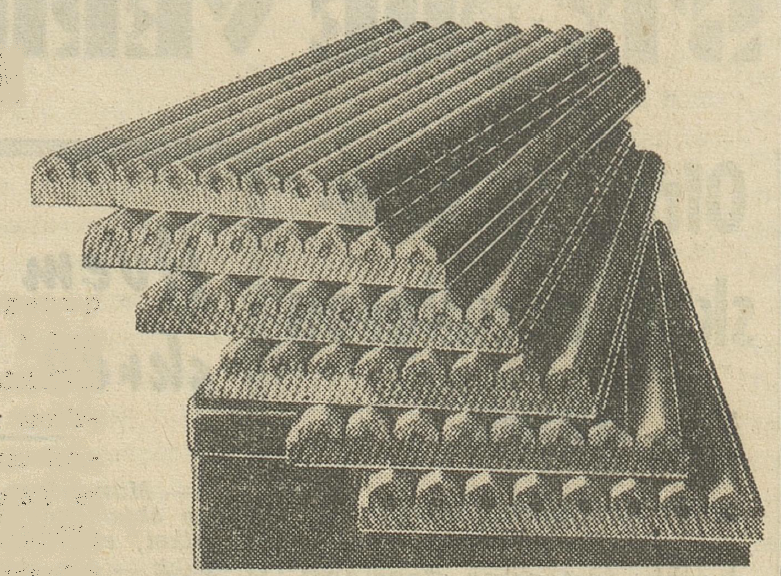
Nibby Sunday – The five Norwegian pencil factories that was NOT owned by two brothers from Senja
Over the years, there have been several attempts to start up pencil production here in Norway. The most famous examples are Den Norske Blyantfabrikk and Oslo Blyantfabrikk, which I wrote a comprehensive article about in May 2022 (published in English in August 2023). In my research about the two Senja brothers who each started a pencil factory, I also found references to several other Norwegian pencil factories. In this article, I will share what I’ve been able to find about these lesser-known factories.
Several sources state that Den Norske Blyantfabrikk was both the first and the only pencil factory in Norwegian history. In my article about the two brothers who each started a pencil factory, I showed that Den Norske Blyantfabrikk and Oslo Blyantfabrikk were two separate factories, contrary to several erroneous sources, which claimed that they were one and the same factory, operating under two different names. But these two weren’t the only ones either, and as we’ll see towards the end of this article, the notion that Den Norske Blyantfabrikk was the first pencil factory in Norway, might also be in jeopardy. There might have been others who were engaged in pencil production long, long before.
Norrøna Pencil Factory
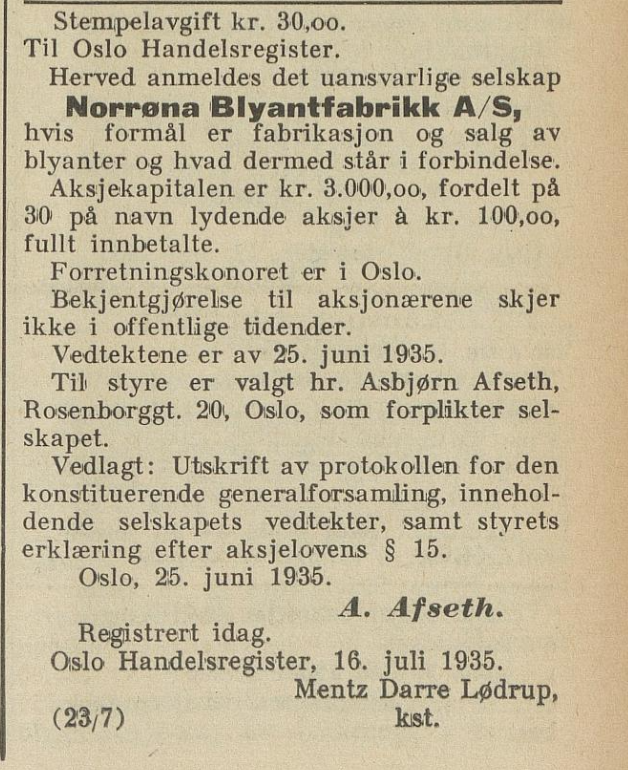
On July 16, 1935, Norrøna Blyantfabrikk A/S was registered in the Oslo Trade Register. The plan was to start manufacturing and selling pencils and accessories. The owner was Asbjørn Afseth. I have not been able to find any more information about Norrøna, until they changed their name to A/S Asfax in 1958. Asbjørn Afseth was still the owner, and it was said that Asfax was a direct continuation of the Norrøna Pencil Factory. Their main objective was still production. It seems that they actually managed to keep the pencil factory going for over 20 years. I have not been able to track down a single advertisement, nor any newspaper articles or notices from this factory, beyond these entries in the Oslo Trade Register. The business continued under the Asfax name for another 16 years before going bankrupt in 1974.
This is quite interesting, because Norrøna Blyantfabrikk/Asfax was actually active in Oslo more or less at the same time, and for just as long as Den Norske Blyantfabrikk and Oslo Blyantfabrikk, but unlike the two more well-known factories, Norrøna was pretty anonymous, at least in the media. One can wonder how they managed to keep the operation going through all those years.
Norsk Pencil
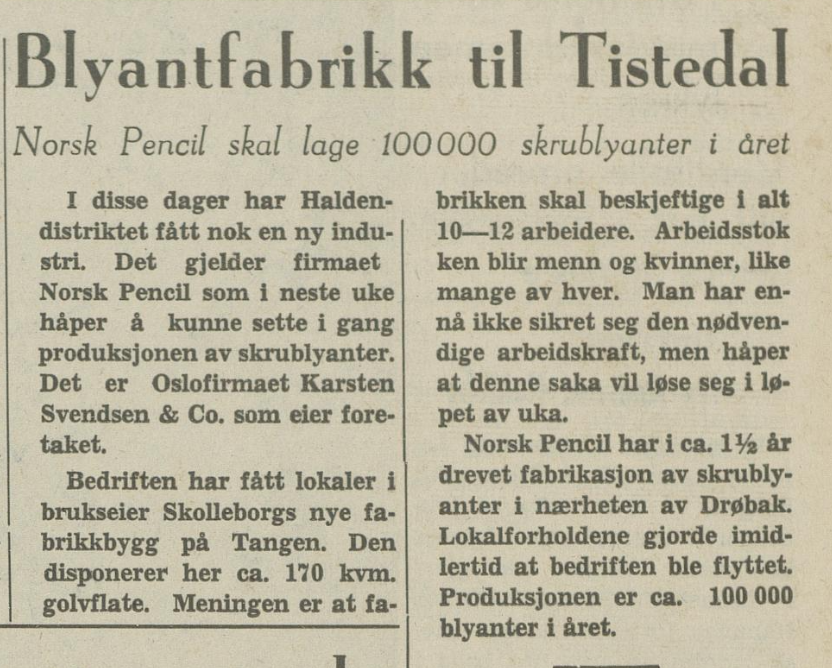
Another factory that received a little more attention was Norsk Pencil, owned by Carsten Svendsen, Jens Svendsen and Carl Haar. This factory also started in Oslo, and was established in 1949. Already in 1950, they moved out of Oslo. First to Drøbak, where they were situated for six months, and then to Tistedal in Halden. Norsk Pencil did not make traditional wood-cased pencils, but mechanical pencils. On August 11, 1950, the newspaper Halden Arbeiderblad wrote that the factory had moved into premises in “farmer Skolleborg’s new factory building on Tangen”, where they had 170 square meters to work in. The plan was to employ 10-12 workers and produce around 100,000 mechanical pencils a year. However, this factory did not last very long. In January 1953, it was reported to the Oslo Trade Register that they had ceased operations.
Color pencil factory in Kodal
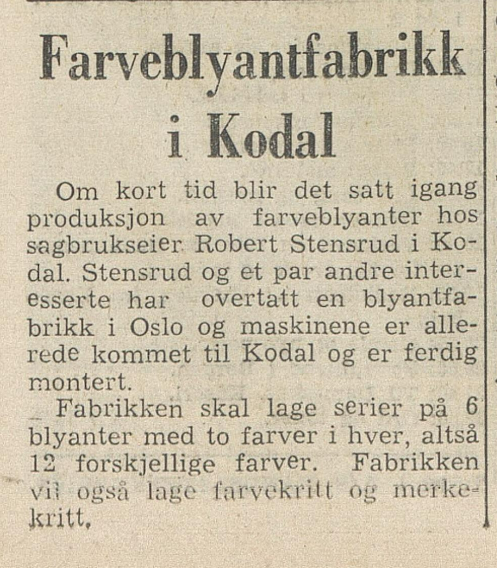
The following year, on June 2, 1954, newspaper Sandefjords Blad reported that sawmill owner Robert Stensrud in Kodal had taken over machinery from a pencil factory in Oslo, and was to start production of colored pencils and chalk. They were to produce pencils in twelve different colours. What happened next with this enterprise is not known. I also don’t know which Oslo factory they got the machines from. It could of course have been Norsk Pencil, as they had recently gone under, but as they made mechanical pencils, the same machines could probably not be used for colored pencil production. However, both Den Norske Blyantfabrikk and Oslo Blyantfabrikk invested a lot of money in new equipment in the years after the war. Perhaps it was old machines from one of these factories that ended up in Kodal?
Just a few hours after this article was first published, I received a message from Kjartan Skogly Kversøy. He had been in contact with one of the descendants of Robert Stensrud, who taold him that the pencils were sold under the brand name TEGNO, but that the factory only kept going for a short time.
Pensa Pencil factory
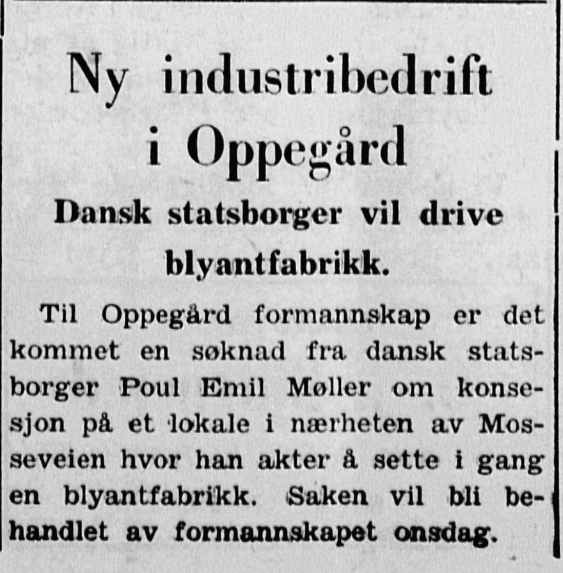
In the late summer of 1954, the same year that Stensrud started his factory in Kodal, a pencil factory was also started in Oppegård. This was owned by a Dane named Poul Emil Møller. Here, too, it has proved difficult to find any detailed information, but the factory kept going for a year, before it burned down under dramatic circumstances on the night of August 10, 1955. The newspaper Arbeiderbladet reported on this day that “two large wooden buildings at Gamle Ljansbruket on the border with Oppegård caught fire last night at 0130 and there was a large call from four Oslo stations and the Oppegård fire brigade”. Furthermore, they wrote “already at 1.45 the fire was characterized as a million fire [very severe and expensive fire]. The Oslo Port Authority’s large warehouse was then all burnt down and there was not much left of Nils Møller’s pencil factory by the Ingierstrand bridge”.
The factory at Oppegård is also referred to as Pensa Blyantfabrikk. Nils Møller was the foreman, and lived in an apartment building right next to the factory. He barely managed to get himself and his family out before the building burned down, but lost everything he owned in the fire, and the pencil factory never started up again.
Englisdahlske Blyants- og Isenfarve-Værk
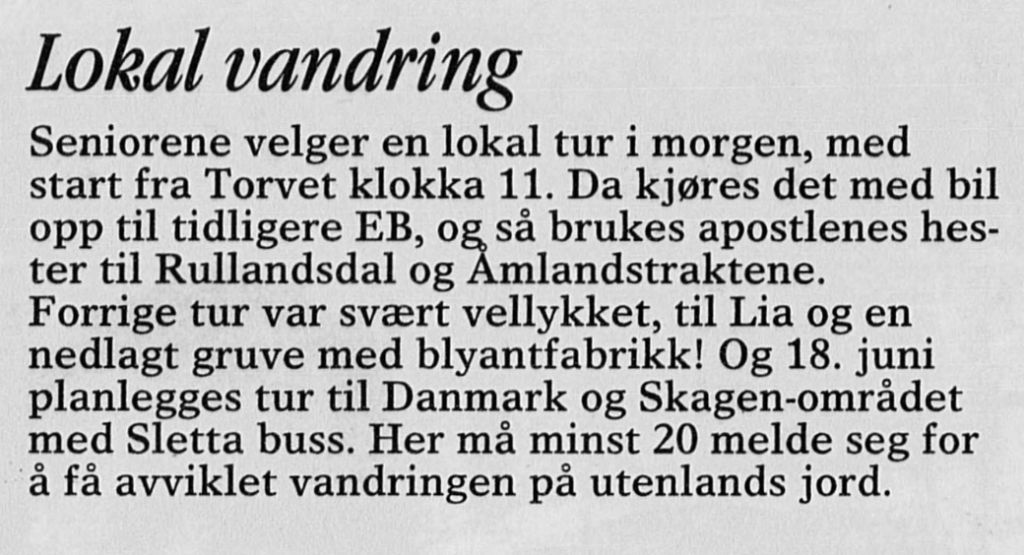
I have found a vague reference to a fifth pencil factory as well. On May 27, 2003, there was a small notice in the newspaper Aust-Agder Blad about a trip for seniors that had gone to “Lia and an abandoned mine with a pencil factory”. “Lia” can be almost anywhere (the word basically means “foothills”), and it took me quite a bit of searching before I was able to find any hints as to exactly where this could be, and which mine it was.
It is most likely Englisdahlske Blyants- og Isenfarve-Værk (Englisdahlske pencil and graphite works), at Bjørnåsvannet in East-Agder. This was Norway’s first graphite mine, started in 1768 by Gustav Pedersen Engzelius. The plant was shut down and restarted several times. When Gustav Pedersen Engzelius died, his son Jens took over the operation, but the mine was closed in 1775. A few years later, Jens also died, and his widow, Else Engzelius, eventually took up the baton and started the mine again in the 1780s. With that, she probably became Norway’s first female mining director.
There have been many graphite mines in Norway over the years. Perhaps the most famous – Skaland Grafitverk – was located in Senja, and you might wonder if it perhaps helped inspire the Wassvik brothers, who came from Senja, to start their pencil factories in Oslo in the 1930s. Whether Englisdahlske Blyants- og Isenfarve-Værk actually had a pencil factory, or whether it was only a graphite mine, is perhaps a bit difficult to say for sure. This was before the industrial revolution, and the mass production of wooden pencils. The pencils of the 18th century did not look much like the ones we use today. It was more common to take a thin piece of graphite and wrap it in either string or leather. In other words, Englisdahlske was probably not a pencil factory as we define it today, but it was perhaps the closest you would get in the second half of the 18th century. It is not inconceivable that they may have sold graphite that was cut to the correct width and length to be used as a drawing tool, and that under the standards of the time this may have qualified them to be referred to as a pencil factory.
If we define Englisdahlske as a pencil factory, we can no longer say that Den Norske Blyantfabrikk was Norway’s first. On the contrary, Gustav Pedersen Engzelius started his business a full 164 years before Jens Hagerup established his factory in Oslo in 1932.
The Englisdahlske graphite mine has also given name to a road right next to where the mine was situated. At the northern end of Bjørnåsvannet we find Blyantverksveien (“the pencil works road” in English”). As far as I have been able to find out, none of the other Norwegian pencil factories have been honored with a street name.
Sources
(All sources are in Norwegian)
Norsk Kunngjørelsestidende, 21.08.1935 – «Norrøna Blyantfabrikk A/S»
Handelsregistre for Kongeriket Norge, 1949 – «Norsk Pencil»
Halden Arbeiderblad, 11.08.1950 – «Blyantfabrikk til Tistedal»
Fredriksstad Blad, 12.08.1950 – «Blyantfabrikk til Tistedalen»
Handelsregistre for Kongeriket Norge, 1953 – «Norsk Pencil, C. Svendsen & Co.»
Sandefjords Blad, 02.06.1954 – «Farveblyantfabrikk i Kodal»
Østlandets Blad, 02.08.1954 – «Ny industribedrift i Oppegård»
Arbeiderbladet, 10.08.1955 – «Storbrann i natt ved Ljansbruket»
Nordisk Tidende, 08.09.1955 – «Skade for mange millioner ved brannen på Ljansbruket, Oslo»
Stortingsforhandlinger vol. 99, nr. 1B, 1955 – «Blyanter, fyllepenner og penneholdere»
Handelsregistre for Kongeriket Norge, 1959 – «A/S Asfax»
Handelsregistre for Kongeriket Norge, 1975 – «A/S Asfax»
Volund – Årbok for selskapet Norsk teknisk museum, 1992 – «Det Englisdahlske Blyants- og Isenfarve-Værk»
Bergtatt – Ane K. Engviks blogg, 31.07.2019 – «Jakten på Norges eldste grafittgruve»
Aust-Agder Blad, 27.05.2003 – «Lokal vandring»